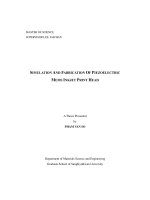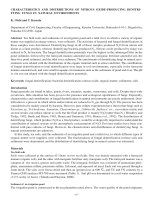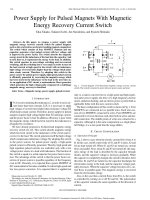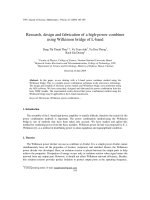DISGN AND FABRICATION OF HIGH VOLTAGE POWER SUPPLY FOR RADIATION DETECTOR
Bạn đang xem bản rút gọn của tài liệu. Xem và tải ngay bản đầy đủ của tài liệu tại đây (1.96 MB, 46 trang )
VIETNAM NATIONAL UNIVERSITY, HANOI
VNU UNIVERSITY OF SCIENCE
FACULTY OF PHYSICS
DUONG DINH QUY
DESIGN AND FABRICATION OF HIGH VOLTAGE
POWER SUPPLY FOR RADIATION DETECTOR
Submitted in partial fulfillment of the requirements for the degree of
Bachelor of Science in Nuclear Technology
(Advanced Program)
Hanoi - 2017
VIETNAM NATIONAL UNIVERSITY, HANOI
VNU UNIVERSITY OF SCIENCE
FACULTY OF PHYSICS
DUONG DINH QUY
DESIGN AND FABRICATION OF HIGH VOLTAGE
POWER SUPPLY FOR RADIATION DETECTOR
Submitted in partial fulfillment of the requirements for the degree of
Bachelor of Science in Nuclear Technology
(Advanced Program )
Supervisor: Dr. NGUYEN THE NGHIA
Hanoi - 2017
ACKNOWLEDGEMENT
I have completed my thesis which is a partial fulfillment of requirement for
the degree of Bachelor in Nuclear Technology.
On this opportunity, I would like to express my gratitude to the Department
of Nuclear Physics, Faculty of Physics, VNU-University of Science generally and
especially to my supervisor Dr. Nguyen The Nghia for his help, advice and
guidance throughout the process of collecting information, analyzing, experiment
and completing the thesis.
I would also like to thank my teacher Bui Thi Hoa for her assistance and
kind attitude in the process of doing this thesis.
To my family, I would like to express millions of thanks to them for their
support and always understanding in everything. Hence, I would like to thanks to
all my friends for their great cooperation and supports either direct or indirect.
Student,
Duong Dinh Quy
i
Contents
ACKNOWLEDGEMENT ............................................................................................. i
ACRONYMS ................................................................................................................. iv
LIST OF FIGURES ....................................................................................................... v
LIST OF TABLE .........................................................................................................vii
PREFACE .................................................................................................................. viii
CHAPTER 1: INTRODUCTION TO HIGH VOLTAGE POWER SUPPLY ........ 1
1.1. Principle of radiation detector .................................................................... 1
1.2 High voltage power supply ......................................................................... 3
CHAPTER 2: STRUCTURE OF HIGH VOLTAGE POWER SUPPLY ............... 5
2.1 Oscillator ..................................................................................................... 5
2.1.1 Requirement for common Oscillator ................................................... 5
2.1.2.Phase-Shifting Oscillators .................................................................... 8
2.2 Inverse phase amplifier ............................................................................... 9
2.3 Push-pull amplifier .................................................................................... 12
2.4 Ferrite core transformer............................................................................. 15
2.5 Voltage multiplier ..................................................................................... 16
2.6 Stability voltage ........................................................................................ 17
2.7 Low voltage power .................................................................................... 18
CHAPTER 3: CONSTRUCTION OF REALITYS HIGH VOLTAGE CIRCUIT
BOARD ......................................................................................................................... 20
3.1 Low voltage DC power circuit .................................................................. 20
3.2 Calculation for Oscillator .......................................................................... 20
3.3 Biasing for transistor in phase splitter stage. ............................................ 23
ii
3.4 Design for step-up transformer ................................................................. 24
3.5 Voltage divider and stability voltage stage ............................................... 25
3.6 Reality high voltage power supply............................................................ 26
CHAPTER 4: RESULTS AND DISCUSSIONS....................................................... 30
CONCLUSIONS .......................................................................................................... 34
REFERENCES ............................................................................................................ 35
iii
ACRONYMS
List
Acronym
Definition
1
AC
Alternating Current
2
BJT
Bipolar Junction Transistor
3
CW
Cockcroft-Walton
4
DC
Direct Current
5
G-M
Geiger-Muller
6
HUS
Hanoi University of Science
7
OP-AMP
Operational Amplifier
8
PCB
Printed Circuit Board
iv
LIST OF FIGURES
Figure 1.1.Nuclear instrument for radiation detection and measurement ................ 1
Figure 1.2.Gas-filled detector .................................................................................. 2
Figure 1.3.Scintillation detector ............................................................................... 3
Figure 1.4.High voltage level apply for gas-filled detector ..................................... 4
Figure 2.1: Block diagram of the typical radiation detector .................................... 5
Figure 2.2.Conventional form of oscillator with feedback ...................................... 6
Figure 2.3.Phase-shifting oscillator’s principle ....................................................... 8
Figure 2.4. All-pass network filter ........................................................................... 9
Figure 2.5.The phase angle of all-pass network....................................................... 9
Figure 2.6.Common emitter configuration ............................................................ 10
Figure 2.7.Common base configuration ................................................................. 10
Figure 2.8.Common collector configuration .......................................................... 11
Figure 2.9.Transistor with internal resistor ............................................................ 11
Figure 2.10.Class B output characteristics curves ................................................. 13
Figure 2.11.Push-pull power amplifier .................................................................. 14
Figure 2.12.Ferrite core transformer ...................................................................... 15
Figure 2.13.The typical Cockcroft-Walton Multiplier circuit ............................... 17
Figure 2.14.Configuration for stability high voltage ............................................. 18
Figure 2.15.Low voltage DC source ...................................................................... 19
Figure 2.16.AC current and DC current ................................................................. 19
Figure 2.17.Half-wave Rectifier RC-Filter ............................................................ 19
Figure 3.1.DC power ±15V .................................................................................... 20
Figure 3.2.All-pass filter for sinusoidal oscillator ................................................. 21
Figure 3.3.Circuit sinusoidal oscillator .................................................................. 21
Figure 3.4.Simulation of sine wave generator by Proteus 8.5 ............................... 22
Figure 3.5.Phase splitter stage ................................................................................ 23
v
Figure 3.6.Stability voltage stage ........................................................................... 25
Figure 3.7.Schematic diagram circuit for high voltage power supply ................... 26
Figure 3.8.PCB in simulation ................................................................................. 27
Figure 3.9.Printed circuit board in reality .............................................................. 27
Figure 3.10.High voltage power supply circuit board ........................................... 28
Figure 3.11.High voltage power supply has been finally approved ...................... 28
Figure 3.12.Source ±15V DC................................................................................. 29
Figure 4.1.Operating of High Voltage circuit at 2000V ........................................ 32
vi
LIST OF TABLES
Table 2.1.Comparision of three configuration operating BJT ............................... 12
Table 4.1.Determination of high voltage value at 2kV .......................................... 30
Table 4.2.Measurement for four level voltage. ...................................................... 31
Table 4.3 The dependence of the high voltage on the frequency of oscillator ...... 32
vii
PREFACE
High Voltage Power Supply is essential for nuclear radiation detection or
counting system. A high voltage power supply unit that is suitable to use with
Geiger Muller counter, scintillation detector and semi-conductor detector which
are constructed with locally available components. The constructed high voltage
unit is based on push-pull topology driving high frequency transformer. The
desired voltage is rectified and multiplied by voltage multiplier unit provides 2
kV-DC at approximately 1mA maximum output current.
In this study, I will describe how to make a High Voltage Power Supply
from fundamental of theory to manufacture diagram schematic circuit and reality
production. I constructed a high voltage power supply based on the design,
simulation and step by step fabrication stage of High Voltage Supply for G-M
counter and Scintillation detector .
The content of the thesis is divided into four main chapters:
Chapter 1: Introduction to High Voltage Power Supply
Chapter 2: Structure of High Voltage Power Supply
Chapter 3: Construction of High Voltage Circuit Board
Chapter 4: Results and Discussions
viii
Design and Fabrication of High Voltage Power Supply for Radiation Detector
CHAPTER 1
INTRODUCTION TO HIGH VOLTAGE POWER SUPPLY
1.1. Principle of radiation detector
Application of ionizing radiation is remaining widely in the daily lives of
people such as scientific research, industry, medicine, military, and agriculture.
Moreover, safety in work place is very important especially when it involves
radioactive materials. There are four major types of ionizing radiation from
radioactive material: alpha, beta, gamma and X-ray, are part of the electromagnetic
spectrum and ionizing radiation, specifically at its high frequency and short
wavelengths. These ionizing radiations are hazard and cannot be seen, felt or sensed
by the human body in any way. Radiation measuring instruments such as detector
and dosimeters are needed in order to detect the presence of such radiations and
avoid excessive exposure.
Figure 1.1.Nuclear instrument for radiation detection and measurement [1]
The use of appropriate and efficient radiation instruments enables exposures
to be controlled and the doses received to be kept as low as reasonable achievable.
The ability to identify sources of radiation, specific radioisotopes, and measure
1
Design and Fabrication of High Voltage Power Supply for Radiation Detector
quantities of radiation is crucial to environmental monitoring, radiation protection,
and development of security programs. Generally the device is able to detect some
or all of the four major types of ionizing radiation by Geiger Muller counter,
scintillation detector or semi-conductor detector.
A Geiger counter is a metal cylinder filled with low pressure gas sealed in by
a plastic or ceramic window at one end. Running down the center of the tube there's
a thin metal wire made of tungsten. The wire is connected to a high, positive voltage
so there's a strong electric field between it and the outside tube.
When radiation enters the tube, it causes ionization, splitting gas molecules
into ions and electrons. The electrons, being negatively charged, are instantly
attracted by the high voltage positive wire and as they zoom through the tube
collide with more gas molecules and produce further ionization.
Figure 1.2.Gas-filled detector [2]
The result is that lots of electrons suddenly arrive at the wire, producing a
pulse of electricity that can be measured on a meter. The ions and electrons are
quickly absorbed among the billions of gas molecules in the tube so the counter
effectively resets itself in a fraction of a second, ready to detect more radiation.
Geiger-Muller counters can detect alpha, beta, and gamma radiation.
The second most common type of radiation detecting instrument is the
scintillation detector. The basic principle behind this instrument is the use of a
special material which glows or “scintillates” when radiation interacts with it.
2
Design and Fabrication of High Voltage Power Supply for Radiation Detector
Figure 1.3.Scintillation detector[2]
The light produced from the scintillation process is reflected through a clear
window where it interacts with device called a photomultiplier tube. The
photocathode has the unique characteristic of producing electrons when light strikes
its surface. These electrons are then pulled towards a series of plates called dynodes
through the application of a positive high voltage. When electrons from the
photocathode hit the first dynode, several electrons are produced for each initial
electron hitting its surface. This bunch of electrons is then pulled towards the next
dynode, where more electron multiplication occurs. The sequence continues until
the last dynode is reached, where the electron pulse is now millions of times larger,
then it was at the beginning of the tube. At this point the electrons are collected by
an anode at the end of the tube forming an electronic pulse. The pulse is then
detected and displayed by a special instrument. Scintillation detectors are very
sensitive radiation instruments and are used for special environmental surveys and
as laboratory instruments.
1.2 High voltage power supply
Regardless of the type of detector, the most important component is also high
voltage power supply. It is essential for nuclear radiation detection or counting
system. When a high voltage is applied an electric field is created by the potential
difference between the electrodes. Electrons and positively charged gas atom of
each ion pair accelerate to anode and cathode, respectively, resulting in an electric
signal in the circuit that can be correlated to radiation exposure and displayed as a
value.
3
Design and Fabrication of High Voltage Power Supply for Radiation Detector
The voltages can vary widely depending upon the detector geometry and the
gas type, pressure and type of detector.
Figure 1.4.High voltage level apply for gas-filled detector[3]
For example, the different voltage regions are indicated schematically
in Figure 1.4. There are six main practical operating regions of gas-filled detector,
where three are useful to detect ionizing radiation: Ionization chamber, proportion
and Geiger Muller region. The voltage is applied about hundreds of volts.
For the high voltage power supply of the photoelectric multiplier tube, the
output voltage depending on the different types of photomultiplier tubes to hundreds
of volts to three kilovolts and adjustable. The output current is approximately a few
mA. In order to meet the detector output and count rate into a good linear
relationship, reduce fluctuation error, so the stability of the high voltage power
demand is very high.
In my graduation paper, I focus on the designed high voltage power supply
capable of converting 15V into 2kV. The output high voltage can be adjusted at any
suitable value by adjusting the mechanical control. The basic principle behind this
instrument is the use of DC-DC converter based on a push-pull topology utilizing
power bipolar junction transistor switches, a center-tapped ferrite core transformer,
and an analog feedback control system.
Specially, this design has an oscillator capable of adjusting frequency
operating circuit so that the efficiency of high voltage power supply is rather high.
4
Design and Fabrication of High Voltage Power Supply for Radiation Detector
CHAPTER 2
STRUCTURE OF HIGH VOLTAGE POWER SUPPLY
The high voltage power supply of the system is realized by the DC-DC
converter using transistor. The main unit of the method is an oscillator, low voltage
DC to the oscillator power supply, the AC output of the oscillator is boosted by a
step-up transformer, and after the rectifier, the filter is used to obtain the DC high
voltage. The block diagram of the typical radiation detector is as shown in Figure.
2.1.
Figure 2.1: Block diagram of the typical radiation detector
2.1 Oscillator
There is a need of an oscillator in the inverter circuit for producing stable
oscillating AC output. Harmonic oscillator of adjustable frequency is used in DCDC power inverter. The frequency of oscillation of the required AC output is
determined by the values of capacitor and resistors, this is all of purpose in this part.
2.1.1 Requirement for Common Oscillator
Oscillator are circuits that produce specific, periodic waveforms such as
square, triangular, saw-tooth, and sinusoidal. They generally use some form of
active device, operational amplifier (Op-amp), transistor or crystal surrounded by
passive devices such as resistors, capacitors, and inductors, to generate the output.
There are two main classes of oscillator: sinusoidal and relaxation.
Sinusoidal oscillators consist of amplifiers with RC or LC circuits that have
5
Design and Fabrication of High Voltage Power Supply for Radiation Detector
adjustable oscillation frequencies, or crystals that have a fixed oscillation frequency.
Relaxation oscillators generate triangular, saw-tooth, square, pulse, or exponential
waveforms. The focus here is on sinusoidal oscillators, created using operational
amplifiers op-amps[5].
Sinusoidal oscillators are used as references or test waveforms by many
circuits. Thus, a sine wave may be the input to a device or circuit. In this case,
sinusoidal oscillator is input of amplify stage. Op-amp sine wave oscillators operate
without an externally applied input signal. Instead, some combination of positive
and negative feedback is used to drive the op-amps into an unstable state, causing
the output to cycle back and forth between the supply rails at a continuous rate. The
frequency and amplitude of oscillation are set by the arrangement of passive and
active components around a center op-amps. The basic characteristic of harmonic
oscillator is frequency operating circuit, output amplitude, stableness and
efficiency[5].
Depending on the purpose of use, the design may pay particular attention to
some parameters or lower the requirements for other parameters, so depending on
the requirements of use, considering and determining parameters for reasonable.
Regardless of the type of oscillator in general, the principle of operation of
the oscillators are similar.
The principle of a general oscillator is show in figure 2.2. The oscillator
consist of two components: amplifier and feedback. The gain of them is a complex
number. In order for the circuit to oscillate, the amplitude and phase conditions
must be met.
Figure 2.2.Conventional form of oscillator with feedback[28].
6
Design and Fabrication of High Voltage Power Supply for Radiation Detector
ik
Amplifier have a rude amplify signal input, its amplify gain is K K .e
and the feedback gain is K fb K .e
i fb
,
[28].
If input signal is X in with condition supposed K .K fb 1, then X 'out X in
because of X 'out K .K fb . X in .
Therefore, input signal of amplifier block X in and output signal of feedback
block X 'out is the same amplitude and phase, so output signal will constant when
we connect point a with point a’. This is the positive feedback oscillator. Clearly, in
this case, circuit only oscillate when it satisfies condition about amplitude and
phase:
K .K fb 1
or written another way
i (k fb )
K .K fb K .K fb .e
1
(1)
With :
K -Modulus of amplify factor
K fb -Modulus of feedback factor
k - Phase shifting angle of amplifier
fb -Phase shifting angle of feedback circuit
From the mathematical complex formula (1), we have two real condition
requirement of oscillator about amplitude and phase:
Requirement of amplitude: K .K fb 1
(2)
Requirement of phase: fb k 2n with n= 0, ±1, ±2….
(3)
is total phase shifting angle of amplifier and feedback, it show that
oscillator circuit is only oscillate when gain’s amplifier can be compensate waste of
feedback circuit. Simultaneous, output of feedback circuit has the same phase with
input amplifier signal[28].
There are three case of oscillator circuit will appear in operation:
7
Design and Fabrication of High Voltage Power Supply for Radiation Detector
− If K .K fb 1, amplitude will descend as an exponential function, oscillation
will attenuation.
− If K .K fb 1, output signal is sine-wave with frequency fo and constant
amplitude.
− If 0 K .K fb 1 , amplitude will progressive as an exponential function.
In conclusion, oscillator is only operating when in the first instance initial we
have K .K fb 1 for amplitude progressive to saturation mode of circuit, after that
amplify gain descend to behavior K .K fb 1. In that time, oscillation is not sine
wave, therefore we always need control amplify gain to satisfy K .K fb 1 and
establish this state[28].
2.1.2.Phase-Shifting Oscillators
This graduation paper will describes a phase shift oscillator based on phase
shifting networks called all-pass networks. It also uses a basic automatic gain
control circuit to stabilize the amplitude of the output. At first, the principle of
phase-shifting oscillator is shown in figure 2.3[6]:
Figure 2.3.Phase-shifting oscillator’s principle[6]
The circuit is based on two 90o phase-shifting networks, followed by an
inverter stage, giving a total loop phase shift of 360o.
The phase-shifting network is in fact a first order all-pass filter, the transfer
function of which is defined by F(s) s o o , where o is the corner frequency.
s
This function has a constant magnitude equal to 1 at all frequencies, while the phase
shift varies from 0o to 180o. The phase shift attains 90o at the corner frequency o ,
this will thus be the oscillation frequency.
8
Design and Fabrication of High Voltage Power Supply for Radiation Detector
A circuit that provides unity gain with variable phase shift, called an all-pass
network, is shown in Figure 2.4
Figure 2.4. All-pass network filter[6]
The magnitude of thus, always one and the phase angle is given by
180o 2arctg( ) . The polar plot is:
o
Figure 2.5.The phase angle of all-pass network[6]
The oscillation frequency can be adjusted by varying Ro or Co. Since there
are two all-pass networks used in the oscillator circuit, a two-ganged element will
be required to adjust the frequency[6].
2.2 Inverse phase amplifier
In order to properly drive a push-pull output stage of an amplifier we need
two signals of equal voltage and opposite phase. In this part, I will introduce three
operating configuration of bipolar junction transistor (BJT).
Normally whatever signals we want to amplify will be of the order millivolts
or less. If we directly input these signals to the amplifier they will not get amplified
as transistor needs voltages greater than cut in voltages for it to be in active region.
Only in active region of operation transistor acts as amplifier. So we can establish
9
Design and Fabrication of High Voltage Power Supply for Radiation Detector
appropriate DC voltages and currents through BJT by external sources so that BJT
operates in active region and superimpose the AC signals to be amplified. The DC
voltage and current are so chosen that the transistor remains in active region for
entire AC signal excursion. All the input AC signals variations happen around
quiescent point[7].
The bipolar junction transistor (BJT) has three terminals, so can be used in
three different configurations with one terminal common to both input and output
signal. The circuits shown here are drawn without biasing and power supplies for
clarity.
Figure 2.6.Common emitter configuration[8]
The common emitter configuration has the emitter terminal common to both
the input and output signal. The arrangement is the same for a PNP transistor,
except that the power supplies will have the opposite polarity. Used in this way the
transistor has the advantages of medium input impedance, medium output
impedance, high voltage gain and high current gain.
Figure 2.7.Common base configuration[9]
10
Design and Fabrication of High Voltage Power Supply for Radiation Detector
When the base is used as the common terminal, the transistor will have a low
input impedance, high output impedance, unity or less current gain and high voltage
gain. This configuration also realizes the best high frequency performance.
Figure 2.8.Common collector configuration[8]
This last configuration is also commonly known as the emitter follower. This
is because the input signal is applied to the base and passes out at the emitter with
little loss. Stage properties are high input impedance, very low output impedance, a
unity (slightly less) voltage gain and high current gain. The circuit is also used
extensively as a "buffer" converting impedance's or for feeding or driving long
cables or low impedance loads.
From figure 2.9, we can determine some characteristics type of configuration
transistor, emitter common, collector common and base common.
Figure 2.9.Transistor with internal resistor[8]
11
Design and Fabrication of High Voltage Power Supply for Radiation Detector
Table 2.1.Comparision of three configuration operating BJT[8]
AMPLIFIER TYPE
INPUT/OUTPUT PHASE
RELATIONSHIP
COMMON
BASE
COMMON
EMITTER
COMMON
COLLECTOR
0°
180°
0°
HIGH
MEDIUM
LOW
VOLTAGE GAIN
CURRENT GAIN
a
POWER GAIN
LOW
HIGH
MEDIUM
LOW
MEDIUM
HIGH
HIGH
MEDIUM
LOW
INPUT RESISTANCE
OUTPUT RESISTANCE
From the characteristic of three configurations, This paper selected two
configuration for this stage: emitter common and collector common. Therefore, two
signals of equal voltage and opposite phase by voltage divider biasing for transistor.
The calculation will illustrate in the next chapter.
2.3 Push-pull amplifier
Amplifier circuits form the basis of most electronic systems, many of which
are required to produce high power to drive some output device. There are many
different types of power amplifiers – class A, class B, class C and class AB. This
thesis mainly deals with class B power amplifiers. In Class B amplifier, the positive
and negative halves of the signal are dealt with by different parts of the circuit. The
output devices continually turn on and off. Class B operation has the following
characteristics[10].
12
Design and Fabrication of High Voltage Power Supply for Radiation Detector
Figure 2.10.Class B output characteristics curves[11]
The advantage of the class B push-pull amplifier design over the class A
design is greater output power capability. With a class A design, the transistor
dissipates a lot of energy in the form of heat because it never stops conducting
current. At all points in the wave cycle it is in the active mode, conducting
substantial current and dropping substantial voltage. This means there is substantial
power dissipated by the transistor throughout the cycle. In a class B design, each
transistor spends half the time in cutoff mode, where it dissipates zero power (zero
current equal to zero power dissipation). This gives each transistor a time to rest and
cool while the other transistor carries the burden of the load. Class A amplifiers are
simpler in design, but tend to be limited to low power signal applications for the
simple reason of transistor heat dissipation[10].
Push-pull amplifier is mostly used in situations where low distortion, high
power and higher efficiency is required. The basic operation of a push pull amplifier
is as follows: The signal to be amplified is first split into two identical signals 180o
out of phase. Generally the splitting is done using an inverse phase amplifier in
before part.
13
Design and Fabrication of High Voltage Power Supply for Radiation Detector
Figure 2.11.Push-pull power amplifier
The conduction angle for this type of amplifier circuit is only 180o or 50% of
the input signal. This is pushing and pulling effect of the alternating half cycles by
the transistors. When switch Q1 is on, current flows through the top half of the
primary side of transformer TR1, expanding the magnetic field in TR1. The
expanding magnetic field induces a voltage across TR1 secondary. When Q1 turns
off, the magnetic field in TR1 collapses and after a period of dead time, Q2 switches
on. Current flows through the bottom half of the transformer and the magnetic field
in TR1 expands. The direction of the magnetic flux is opposite that of Q1. The
combined half cycles then produces an output for a full 360o of operation. After a
period of dead time, Q1 conducts and the other cycle continuous repeats. It is very
important that Q1 and Q2 are not turned on at the same time. If they were, they
would short circuit the supply. Therefore the conduction time of each transistor
must not exceed half of the total period for one complete cycle. It is also important
to make sure the magnetic behavior is uniform; otherwise the transformer will
saturate and destroy Q1 and Q2. This requires that the individual conduction times
of Q1 and Q2 be exactly equal.
The push pull topology is an ideal choice for this DC-DC converter for
multiple reasons. The most important reason is the isolation between the source and
output provided by the magnetics in the transformer. Another deciding factor is the
simplicity of the switching with the topology to reduce complexity of the design and
improve efficiency, the DC-DC supply should be designed with passive cooling.
14
Design and Fabrication of High Voltage Power Supply for Radiation Detector
2.4 Ferrite core transformer
Ferrites is a material that are used in transformer contain iron oxides
combined with Nickel, Zinc and Manganese compounds. They have low coercivity
and are call soft ferrites. It can easily reverse direction without dissipating much
energy. Therefore, It usually is used in high frequency transformer.
The ferrite transformer is a device that converts an AC voltage or DC pulse
high frequency across the primary coil winding into a different AC voltage across
the secondary coil winding. This is accomplished by using two closely spaced coils
of different number of turns, one is called the primary, and the other is the
secondary. The primary coil has a number of turns denoted by Np , and the
secondary coil has Ns number of turns.
Figure 2.12.Ferrite core transformer [14]
Then the voltage across the primary Vp , is related to the voltage across the
secondary Vs , according to:
N
N
p
s
V
V
in
(4)
out
For transformer design, the push-pull transformer will require a center tap,
meaning it will require twice the number of primary turns.
The formula for calculating the number of required primary turns is[12]:
N
p
V
in
10
8
4, 44 f B max Ac
Where
15
(5)









